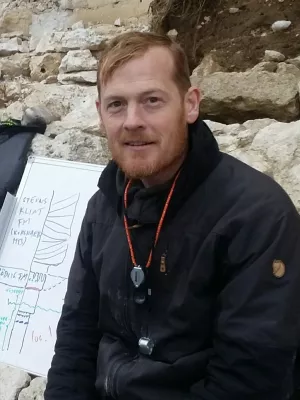
Mikael Calner
Professor

Significance of a halysitid-heliolitid mud-facies autobiostrome from the Middle Silurian of Gotland, Sweden.
Author
Summary, in English
A low-diversity halysitid-heliolitid autobiostrome from the Late Wenlock Halla Formation at Blåhäll 1, Gotland, indicates a brief period of particular environmental conditions. The reef is 0.3–0.5 m thick, internally without bedding structures, and had a sheet-like distribution on a low-relief soft-bottom, in marginal platform, graptolitiferous strata (height-width ratio is 1:900 in outcrop). The dominating coral species building this mud-facies biostrome were the tabulates Stelliporella cf. parvistella and Halysites laticatenatus. The rugose coral fauna is dominated by fixosessile and rhizosessile forms with well developed holdfasts, for example Dokophyllum elegantulum. Coral growth forms generally indicate high background sedimentation rates during the growth of the biostrome.
Four successive stages of sea-floor development are discussed: (1) a pre-biostrome stage, (2) a pioneering community stage, (3) a climax-community stage, and (4) a post-biostrome stage. Stratigraphically, these stages show an increased carbonate-siliciclastic ratio, a decreased phosphorus content, somewhat lighter {delta}18O stable isotopes, and an increased rate of bioturbation. The climax-community stage coincides with a bloom(?) in paleocopid and metacopid ostracodes.
The biostrome differs from all other Wenlock-Ludlow reefs on Gotland in its geographic and stratigraphic isolation on the seaward slope of the carbonate platform. It was the first re-appearance of a reefal stucture following the oceanic Mulde Event and associated eustasy. On a regional scale, this appearance coincided with an inferred highstand systems tract and the onset of widespread reef growth in the basin indicating that, at least, basin-regional factors controlled reef growth.
Four successive stages of sea-floor development are discussed: (1) a pre-biostrome stage, (2) a pioneering community stage, (3) a climax-community stage, and (4) a post-biostrome stage. Stratigraphically, these stages show an increased carbonate-siliciclastic ratio, a decreased phosphorus content, somewhat lighter {delta}18O stable isotopes, and an increased rate of bioturbation. The climax-community stage coincides with a bloom(?) in paleocopid and metacopid ostracodes.
The biostrome differs from all other Wenlock-Ludlow reefs on Gotland in its geographic and stratigraphic isolation on the seaward slope of the carbonate platform. It was the first re-appearance of a reefal stucture following the oceanic Mulde Event and associated eustasy. On a regional scale, this appearance coincided with an inferred highstand systems tract and the onset of widespread reef growth in the basin indicating that, at least, basin-regional factors controlled reef growth.
Department/s
- Lithosphere and Biosphere Science
Publishing year
2000
Language
English
Pages
509-521
Publication/Series
Palaios
Volume
15
Issue
6
Links
Document type
Journal article
Publisher
SEPM Society for Sedimentary Geology
Topic
- Geology
Keywords
- Gotland
- Silurian
- reef
- Palaeoecology
Status
Published
ISBN/ISSN/Other
- ISSN: 1938-5323

